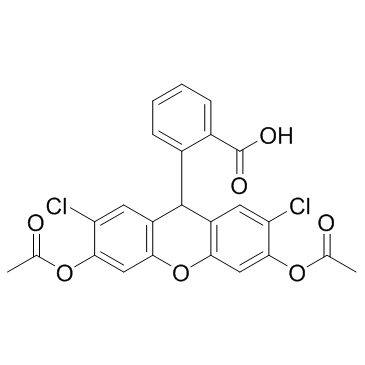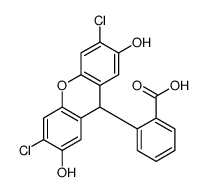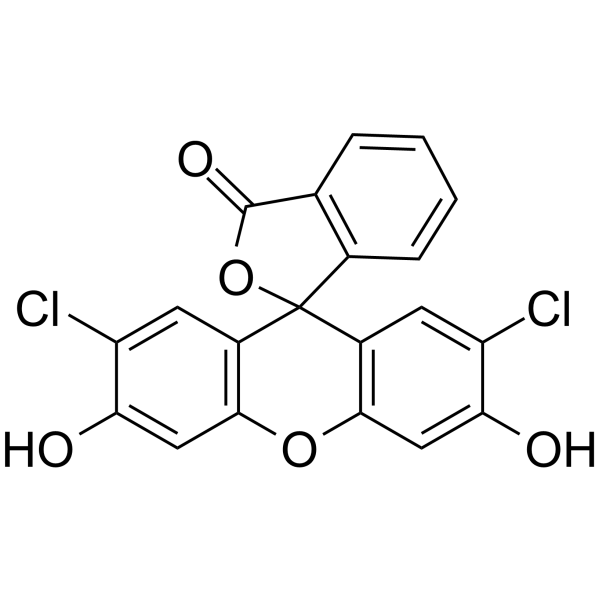4091-99-0
| Name | 2-(3,6-diacetyloxy-2,7-dichloro-9H-xanthen-9-yl)benzoic acid |
|---|---|
| Synonyms |
2,7-Dichlorodihydrofluorescein diacetate
H2DCFDA [2',7'-Dichlorodihydrofluorescein diacetate] MFCD00128955 2-(3,6-Diacetoxy-2,7-dichloro-9H-xanthen-9-yl)benzoic acid Leucodiacetyldichlorofluorescein H2DCFDA 2',7'-dichlorofluorescin diacetate Benzoic acid, 2-[3,6-bis(acetyloxy)-2,7-dichloro-9H-xanthen-9-yl]- DCFH |
| Description | H2DCFDA is a cell-permeable probe used to detect intracellular reactive oxygen species (ROS). |
|---|---|
| Related Catalog | |
| In Vitro | Analysis of H2DCFDA probe oxidation by means of flow cytometry technique showed that the basal level of ROS in difESCs is about 6–7 times larger than that in embryonic stem cells (ESCs). Both H2DCFDA and DCFDA probes are non-fluorescent in their initial form but they undergo multistep conversion inside the cell that results in the formation of fluorescent product dichlorofluorescein (DCF). The only difference between these two probes is that the conversion of H2DCFDA involves oxidation. Therefore, fluorescence of the H2DCFDA-treated cells depends on the intracellular ROS level, in contrast to fluorescence associated with the DCFDA probe. Surprisingly, flow cytometry analysis shows that the difference between fluorescence levels of ESCs and difESCs loaded with H2DCFDA is close to the difference between the signals from DCFDA-treated cells. The latter indicates a ROS-independent reason for low fluorescent signal of oxidized H2DCFDA in ESCs[1]. |
| Kinase Assay | H2DCFDA is dissolved in DMSO to obtain a 10 mM stock solutions and further diluted before use[1]. ROS Measurements[1] For the detection of intracellular ROS level ,ROS-sensitive probe H2DCFDA is used. Adherent cells (ESCs, difESCs, eMSCs, HeLa, U118) are incubated with 5 µM staining solution in PBS in the dark for 30 min at 37°C, then harvested with 0.05% trypsin-EDTA solution, suspended in a fresh medium, and immediately analyzed with flow cytometer. Lymphocytes, both control and PHA-activated, are resuspended in PBS, incubated with 5 µM of H2DCFDA in the dark for 30 min at 37°C, and immediately analyzed. Along with the H2DCFDA probe, if indicated, ROS-insensitive modification of the fluorescein dye DCFDA is used. The staining procedure is the same as for the H2DCFDA[1]. |
| References |
| Density | 1.5±0.1 g/cm3 |
|---|---|
| Boiling Point | 593.5±50.0 °C at 760 mmHg |
| Melting Point | 209-210ºC(lit.) |
| Molecular Formula | C24H16Cl2O7 |
| Molecular Weight | 487.286 |
| Flash Point | 312.7±30.1 °C |
| Exact Mass | 486.027313 |
| PSA | 99.13000 |
| LogP | 4.62 |
| Vapour Pressure | 0.0±1.8 mmHg at 25°C |
| Index of Refraction | 1.635 |
| Storage condition | 2-8°C |
| Symbol |

GHS07 |
|---|---|
| Signal Word | Warning |
| Hazard Statements | H315-H319-H335 |
| Precautionary Statements | P261-P305 + P351 + P338 |
| Personal Protective Equipment | Eyeshields;Gloves;type N95 (US);type P1 (EN143) respirator filter |
| Hazard Codes | Xi |
| Risk Phrases | 36/37/38 |
| Safety Phrases | S22-S24/25 |
| RIDADR | NONH for all modes of transport |
| WGK Germany | 3.0 |
| HS Code | 2932999099 |
| Precursor 0 | |
|---|---|
| DownStream 2 | |
| HS Code | 2932999099 |
|---|---|
| Summary | 2932999099. other heterocyclic compounds with oxygen hetero-atom(s) only. VAT:17.0%. Tax rebate rate:13.0%. . MFN tariff:6.5%. General tariff:20.0% |




